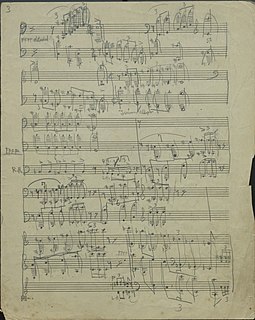
Henry Cowell's 1920 work Fabric, HC 307, is a short piano piece meant to be an exercise in a form of experimental rhythmic notation he had been developing at the time.

Henry Cowell's 1920 work Fabric, HC 307, is a short piano piece meant to be an exercise in a form of experimental rhythmic notation he had been developing at the time.
It was written in the month of September 1922, with the complexity resulting from Cowell's preoccupation with rhythmic exploration and polyrhythmic tendencies. The piece is dedicated to Georgia Kober. [1]
The time signature is a notational convention used in Western musical notation to specify how many beats (pulses) are contained in each measure (bar), and which note value is equivalent to a beat.

Henry Dixon Cowell was an American composer, writer, pianist, publisher and teacher. Earning a reputation as an extremely controversial performer and eccentric composer, Cowell became a leading figure of American avant-garde music for the first half of the 20th century — his writings and music serving as a great influence to similar artists at the time, including Lou Harrison, George Antheil, and John Cage, among others. He is considered one of America's most important and influential composers.

The Tides of Manaunaun is a short piano piece in B♭ minor by American composer Henry Cowell (1897–1965). It premiered publicly in 1917, serving as a prelude to a theatrical production, The Building of Banba. The Tides of Manaunaun is the best known of Cowell's many tone cluster pieces.
A tone cluster is a musical chord comprising at least three adjacent tones in a scale. Prototypical tone clusters are based on the chromatic scale and are separated by semitones. For instance, three adjacent piano keys struck simultaneously produce a tone cluster. Variants of the tone cluster include chords comprising adjacent tones separated diatonically, pentatonically, or microtonally. On the piano, such clusters often involve the simultaneous striking of neighboring white or black keys.

The Piano Sonata No. 2, Concord, Mass., 1840–60 is a piano sonata by Charles Ives. It is one of the composer's best-known and most highly regarded pieces. A typical performance of the piece lasts around 45 minutes.

The negligee or négligée, also known in French as déshabillé, is a form of see-through clothing for women consisting of a sheer, usually long, dressing gown. It is a form of nightgown intended for wear at night and in the bedroom. It was introduced in France in the 18th century, where it mimicked the heavy head-to-toe style of women's day dresses of the time.

The Three Places in New England is a composition for orchestra in three movements by American composer Charles Ives. It was written mainly between 1911 and 1914, but with sketches dating as far back as 1903 and last revisions made in 1929. The work is celebrated for its use of musical quotation and paraphrasing.
The Unanswered Question is a musical work by American composer Charles Ives. Originally paired with Central Park in the Dark as Two Contemplations in 1908, The Unanswered Question was revised by Ives in 1930–1935. As with many of Ives' works, it was largely unknown until much later in his life, and was not performed until 1946.

A Symphony: New England Holidays, also known as A New England Holiday Symphony or simply a Holiday Symphony, is a composition for orchestra written by Charles Ives. It took Ives from 1897 to 1913 to complete all four movements. The four movements in order are:
Indeterminacy is a composing approach in which some aspects of a musical work are left open to chance or to the interpreter's free choice. John Cage, a pioneer of indeterminacy, defined it as "the ability of a piece to be performed in substantially different ways".
Music of Changes is a piece for solo piano by John Cage. Composed in 1951 for pianist and friend David Tudor, it is a ground-breaking piece of indeterminate music. The process of composition involved applying decisions made using the I Ching, a Chinese classic text that is commonly used as a divination system. The I Ching was applied to large charts of sounds, durations, dynamics, tempo and densities.
American avant-garde composer John Cage (1912–1992) started composing pieces for solo prepared piano around 1938–40. The majority of early works for this instrument were created to accompany dances by Cage's various collaborators, most frequently Merce Cunningham. In response to frequent criticisms of prepared piano, Cage cited numerous predecessors. In the liner notes for the very first recording of his most highly acclaimed work for prepared piano, Sonatas and Interludes, Cage wrote: "Composing for the prepared piano is not a criticism of the instrument. I'm only being practical." This article presents a complete list of Cage's works for prepared piano, with comments on each composition. All of Cage's indeterminate works for unspecified forces can also be performed on or with Prepared Piano.
Construction is the title of several pieces by American composer John Cage, all scored for unorthodox percussion instruments. The pieces were composed in 1939–42 while Cage was working at the Cornish School of the Arts in Seattle, Washington, and touring the West Coast with a percussion ensemble he and Lou Harrison had founded. The series comprises three Constructions. A piece titled Fourth Construction, mentioned in several sources, is apparently either an unfinished work from 1942 or, more likely, an early title of the work we now know as Imaginary Landscape No. 2 .
Sonata for Clarinet is an early work by John Cage, composed in 1933. It is also known under its early title, Sonata for One Voice.
IV for Percussion Ensemble, other wise known as IV, by German composer Johanna Magdalena Beyer is a work for percussion ensemble that involves the use of nine different playing surfaces. Each of these playing surfaces are to be chosen by the ensemble director. All other aspects of the work, including dynamics, rhythms, articulations, and, to an extent, tempo, are defined.

The Banshee (1925) is a piano composition by American composer Henry Cowell (1897–1965). It was the first piano piece ever written to be performed entirely free of the keyboard, using only manual manipulation of the strings within the instrument to produce sound via the flesh and nails of the finger.

American composer Henry Cowell wrote one of his first surviving piano pieces, Dynamic Motion, in 1916. It is known as one of the first pieces in the history of music to utilize violent tone clusters for the keyboard. It requires the performer to use various limbs to play massive secundal chords, and calls for keys to be held down without sounding to extend its dissonant cluster overtones via sympathetic resonance. Some of the clusters outlined in this piece are those written for fists, palms, and forearms. The piece is also noted for its extended use of tuplets, featuring triplets, quintuplets, and sextuplets in the melody line.

Henry Cowell's 1938 work Rhythmicana is a suite of piano pieces centered on polyrhythms and dissonant counterpoint. It is known for its unusual time signatures, with the first two movements being in 1
1 time, and the third movement having the polymeter of 3
4 in the right hand and 5
4 in the left.
Henry Cowell wrote the piano piece The Snows of Fuji-Yama, HC 395, in 1924.
Henry Cowell wrote his Variations for Orchestra, HC 833, in 1956.